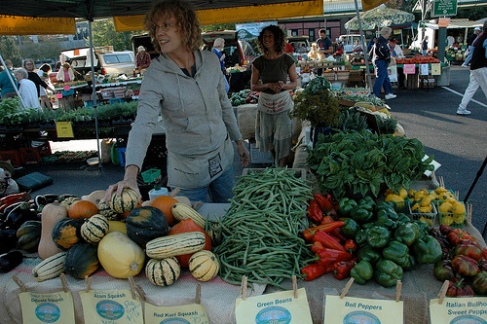By: Stone Irr, Local Food Sourcing and Green Events Planning at the IMU Intern
“A real place finds us mindful of nature.” This quote comes from Scott Russell Sander’s essay collection, A Conservationist Manifesto. Reflecting on the ideal characteristics of community, Sanders introduces his love of a thriving group of people coming together into one environment—the Bloomington Farmer’s Market being his example.

The food, the people, and the vibrancy in the Bloomington City Hall parking lot every Saturday morning continues to remind me of how a real place finds us mindful of nature. How real people find us mindful of relationships. How real food finds us mindful of healthy, sustainable lives.
I began making my summer living arrangements by signing up for two Community Supported Agriculture shares through Freedom Valley Farm and WE Farms. A few of my friends and I collectively purchased these two shares and over the course of the summer, we will pick up our weekly produce and monthly meat share. When I first found out about CSA shares, I was simply excited by the fact that I would be getting a pretty great deal on some fresh produce. It was soon after the share program commenced that noticed a larger narrative unfolding.
Whether at home or at a local restaurant, sitting down to a simple dinner may hold unforeseen impact. The average American citizen consumes about 400 gallons of oil a year through agricultural purposes. The majority of this consumption derives from the trip of a meal from farm to plate—a trip that averages of 1,500 miles. This invisible trail of oil rarely comes to mind while enjoying a nice meal with friends and family.
Through our CSA, my friends and I not only reduce our trips to the local supermarkets (which saves oil consumption and money), but we also actively support local farmers within our area. Instead of our money being divided up by shareholders I have never met, it is comforting to know that our money is being used to support residents in the community. Aside from this comfort, we also stimulate the local economy, reduce the distance that our dollars travel, and foster relationships within the community.
In a world of food convenience, we have many options to indulge—too many options in fact. US farmers now produce 3,900 calories per US citizen—nearly twice your daily-recommended amount. This statistic stands unwavering despite the fact that 800 million people throughout the world are chronically underfed. Why the overproduction? Part lies in our desire for processed foods. Part lies in our desire for an extra-seasonable diet—a reflection of living for our wants and not within our needs. In a way—failing to live within the parameters nature has set for us.
When purchasing local foods, there is almost always an understood standard of freshness. You will typically see standard, seasonal fare at most stands at the farmer’s market. To me, this usually ensures a tastier, more nutrient-filled product. Seasonable produce also ensures that the product you are purchasing was grown within its means—location, climate, and timeline.
As the intern for Local Food Tracking and Green Events Planning at the IMU, I am greatly interested in increasing awareness of the local foods available throughout our community. By implementing a Green Events program at the IMU, I hope to bring the discussion of local, seasonable, and sustainable food to the table and not leave it a foregone conclusion. The impact of what we eat can not go unnoticed forever. We must seize the opportunity for local foods provided by the farming community in the Bloomington area. And why not take advantage? It will leave us with lasting relationships, a thriving community, and healthier lives.
For More Info:
Bloomington Farmer’s Market: http://bloomington.in.gov/farmersmarket
Bloomington Area Community Supported Agriculture: http://www.localgrowers.org/csa-programs/
Seasonal Vegetables: http://cuesa.org/page/seasonality-chart-vegetables


This is so beautiful! i love you
Sweet blog, Stone! Very well-written. Keep up the good work!
Joining a CSA really does make you stop and think about what food you are getting and how you are getting. Another added incentive is that it introduces you to food that you may not have previously considered or even heard of when you make your pickup.
Great blog post! A couple of years ago I thought about joining a CSA, but I didn’t follow through with it. However, it sounds like it’s a great way to learn more about your food, try different types of food, and get to know local farmers. I really enjoy going to the farmers’ market, but I’m sometimes intimated to try different seasonal fruits/vegetables because I don’t know how to prepare them. Since I’ve already purchased the subscription, I feel like I would be more apt to try/experiment with new foods–all the while supporting the local community.
Great post! I think joining a CSA or buying local produce also helps change your ideas of what your food should look like. the tastiest tomatoes I eat during the summer are not the perfectly round, red tomatoes from a huge food producer, they are the dirty, oddly shaped, DELICIOUS ones i get from the farmers market
I’ve also always wanted to joining a CSA, but I never use up the small amount of produce that I get at the grocery before it goes bad. However, I think that’s one of the issues in today’s society – we’re too lazy to make the effort to cook or preserve our goods to make them last. I think if I made the plunge to join a CSA that I would make wiser choices and overall waste less than I do when I only get a couple things from the grocery.
I love this! I never knew that Bloomington locals offered a CSA plan, and I really want to save up to buy one this fall. My uncle has one in Oregon, so I know it’s a great investment.